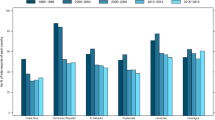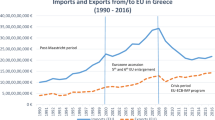Abstract
The paper examines the significance of what is called “the Soviet trade shock” on central and East European economies. The analysis involves two steps: first, the terms-of-trade effect of replacing the CMEA trading rules by market rules is estimated, and second, the impact of the loss of export markets in the former Soviet Union is assessed. The results of estimating the terms-of-trade effect for Hungary and Poland show that the income losses in 1990–1991 have not been as substantial as commonly believed (3.5 percent of GDP and 1.0 percent of GDP, respectively). The decomposition of the fall of total Soviet imports in 1991 into three categories, reflecting the impact of domestic recession, reduction of trade with ex-CMEA, and diversion of imports from ex-CMEA to western countries allowed us to estimate the CMEA-induced part of the trade collapse at 36 to 49 percent of the total fall of exports to the Soviet Union by the CEECs (except Romania), with the impact of domestic recession being in all cases stronger than the CMEA dissolution effect. An attempt has also been made to estimate the impact of the Soviet trade shock on GDP levels in CEECs. The results obtained indicate that the collapse of exports to the Soviet Union in 1991 may have been responsible for about one third of the officially reported GDP fall in Czechoslovakia and Poland, and for more than half of the GDP fall in Bulgaria and Hungary, but the impact of the CMEA-induced export fall was much smaller. The impact of the Soviet trade shock on Romania was negligible. The results obtained suggest a smaller impact of the Soviet trade shock on Hungary and Poland, as compared with some other studies. The conclusions should, however, be treated with caution, because of many untested assumptions underlying the analysis.
Similar content being viewed by others
References
Berg, A., and J. Sachs (1992) “Structural Adjustment and International Trade in Eastern Europe: The case of Poland”,Economic Policy,14, 117–174.
Danielewski, J. (1991) “Selected Problems Involved with Introduction of New Forms of Settlement in Trade with the USSR”, inPolish Foreign Trade in 1990, Foreign Trade Research Institute, Warsaw, 1991.
Durka, B. (1991) “Polish-Soviet Economic Relations”,Discussion Paper No. 21, Foreign Trade Research Institute, Warsaw, 1991.
Klacek J. et al. (1992) “Ekonomicka reforma v CSFR (prubezne hodnoceni)”,Politicka ekonomie,9–10, 1991, 727.
Oblath, G. (1992) “Comment”, in M. Blejer, G.A. Calvo, F. Coricelli, and A.H. Gelb, eds,Eastern Europe in Transition: From Recession to Growth?, World Bank Discussion Papers, No. 196, The World Bank: Washington, D.C.
Oblath, G., and D. Tarr (1991) “The Terms-of-Trade Effects from the Elimination of State Trading in Soviet-Hungarian Trade”, The World Bank,Working Papers, WPS 690, May 1991.
PlanEcon (1992), “The Role of Exchange Rates in Western Investment Decisions in Eastern Europe”, New York, 7 May 1992.
Rodrik D. (1992a) “Foreign Trade in Eastern Europe's Transition: Early Results”, Stanford University, January 1992, mimeo.
Rodrik, D. (1992b) “Making Sense of the Soviet Trade Shock in Eastern Europe: A Framework and Some Estimates”, in M. Blejer, G.A. Calvo, F. Coricelli, and A.H. Gelb, eds,Eastern Europe in Transition: From Recession to Growth?, World Bank Discussion Papers, No. 196, The World Bank, Washington, D.C.
Rosati, D. et al. (1990) “Poland: Impact of Replacing CMEA Trade Regime by a Market Trade Regime”, Foreign Trade Research Institute, Warsaw, 1990, mimeo.
Rosati, D. (1991a) “After the CMEA Collapse: Is a Central European Payments Union really necessary?”,Discussion Paper No. 16, Warsaw, Foreign Trade Research Institute, May 1991.
Rosati, D. (1991b) “The Impact of the CMEA Demise on Polish Industrial Exports to the Soviet Union. An Initial Assessment”, a study prepared for the World Bank, Warsaw, November 1991, mimeo.
UN Economic Commission for Europe (1992)Economic Bulletin for Europe, Vol. 43, New York.
Van Brabant, J.M. (1993) “Economic Recession in the East-The Impact of Changing External Regimes”,Journal of International and Comparative Economics,2 (3), 165–189.
Author information
Authors and Affiliations
Additional information
I would like to acknowledge helpful comments received on earlier drafts of the paper by Daniel Gross, Dieter Hesse, Gabor Oblath, and Mica Panic. The views expressed in the paper are, however, my own responsibility.




